Biking with a dog leash is a fun and rewarding experience for you and your pet. You get to enjoy the fresh air while doing your favorite activity, and your furry friend gets their daily dose of exercise.
Though rewarding, this activity also poses some challenges and risks, as you must moderate your speed and control the steering while keeping an eye on your dog’s safety and comfort. Additionally, you must navigate obstacles and hazards, such as traffic, pedestrians, other dogs, and wildlife.
How can you make biking with a dog leash an enjoyable and positive activity for both of you? Is it safe? Will your dog be scared? What kind of places can we take them?
In this article, we will share tips and tricks on choosing the correct equipment and training your dog, along with some best practices for biking with your dog on a leash. Read on to find out how to do it safely.
Contents
Safety Concerns of Biking With a Dog
There are several safety considerations to make before going biking with your dog.
Most dogs, unless well-trained, are easily distracted or frightened by loud noises. To bike safely, they must be able to avoid reacting to distractions or noises.
If attached to the bike by a leash, a dog may run in the direction of the distraction, which almost guarantees a crash, so proper equipment and training are essential.
Related: Bicycle Safety Facts, Tips & Rules
While your dog’s enthusiasm might match yours, remember to ensure they’re physically fit enough for the task. Gradually increase distance and speed to avoid strain.
Finally, avoid biking with your dog on hot days as they struggle to regulate their core temperature.
What Equipment Do You Need?
Without proper equipment and training, biking with your dog on a leash is dangerous for both of you. Let’s take a look at the items you need to get started.
A Dog Leash for Biking
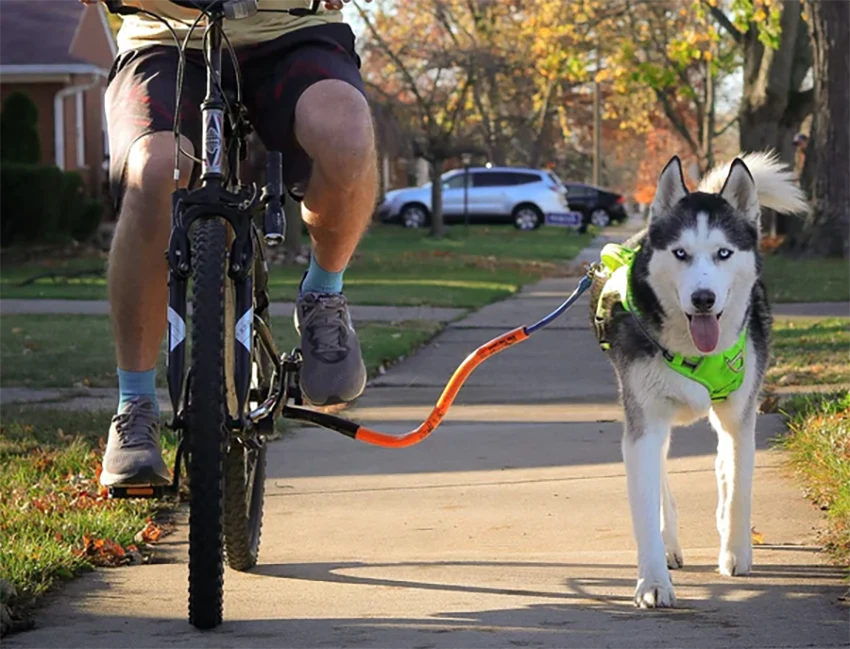
We advise against holding a regular dog leash in your hand while cycling or tying it around your handlebars, as this could result in the leash straying into the spokes or a sudden pull in a different direction, causing a crash.
For these reasons, dedicated bicycle dog leashes have been designed. There are a couple of different options available, and price points vary.
One popular option is a leash that mounts onto the chainstay; another is designed to be worn around your body. It’s down to personal preference which bicycle dog leash you choose; both work well.
However, keep in mind that attaching a leash lower on your bike rather than higher will enhance stability, especially if your dog pulls abruptly and forcefully.
Here are the top dog leashes for biking that we recommend:
- Bike Tow Leash: One of the best and safest options on the market right now. A flexible tow leash that attaches to the chainstay, low on the bike, enhancing stability.
- Walky Dog Leash: A seat tube-mounted dog leash with quick-release and shock-absorption systems. It keeps your dog at a safe distance from the bike and reduces the effect of any sudden moves.
- Malaby V2.0 Dog Leash: A rotatable dog leash made from carbon fiber. It attaches to your bike’s seat post and allows the dog to move freely between the left and the right side of the bike.
- Unicam Retractable Bicycle Dog Leash: A flexible and retractable bike dog leash that attaches to the seat post that gives your dog plenty of room to ride beside the bike. A detachable part doubles as a leash for walking.
A High-Quality Harness
Another key piece of equipment to consider is a high-quality harness instead of a collar, as a collar could hurt the dog’s neck or cause choking.
A harness, worn around the dog’s body, ensures comfort, safety, and maximum control over your dog.
Any harness can work for biking with your dog as long as the material is durable and comfortable.
Any Bike Will Work
Thankfully, you don’t have to worry about the type of bike you own; any bicycle will work for biking with a dog leash.
However, bikes with stable handling and a more upright riding position are favorable, as they provide more control and better visuals of the road or trail ahead, allowing you to identify possible hazards and distractions.
For example, a hybrid bike or a mountain bike will perform better than a performance road bike in this regard, as the riding position is more stable and upright.
A Few Other Things to Remember
Once you’ve got your dog set up with their harness and the leash attached to you or your bike, you’re ready to start training.
However, you should also plan your route and take supplies to ensure a safe and comfortable experience.
Most importantly, bring plenty of water for both you and your dog. Dogs require frequent drinks to stay hydrated, especially in warm weather. Additionally, don’t forget to take bags with you for picking up poop.
On the first rides with your dog, it’s essential to keep an eye on energy levels, nervousness, and overheating, as this type of exercise is likely more strenuous than the dog is used to unless they’re accustomed to running with you already.
How to Train Your Dog for Biking?
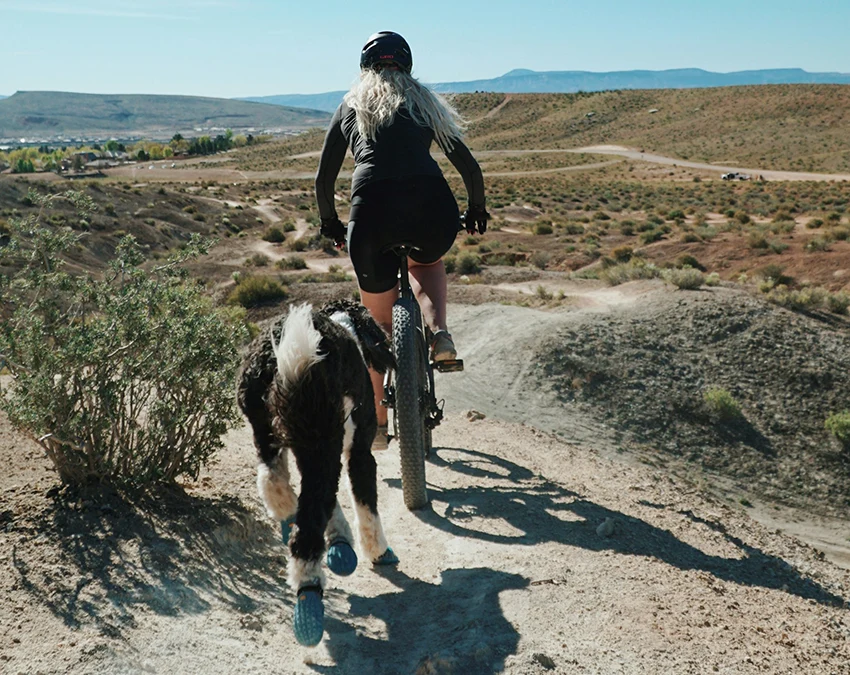
Biking with your dog requires a relatively high level of training to be done safely, including general training, behavior control, and bike-specific training.
Basic Dog Training
Your dog should understand basic obedience commands and be able to regulate their behavior around distractions before joining you on your rides.
- The most important part of basic training is ensuring your dog doesn’t react to distractions by running, chasing, or stopping abruptly. They must be trained to ignore or at least not pull toward distractions such as wild animals, other dogs, food, or interesting smells.
- Being able to execute basic commands reliably is also fundamental. This includes responding to their name to remove attention from a distraction, along with a ‘stay’ command and a ‘come’ command. These can prevent accidents and keep you and your dog safe.
Biking-Specific Training
Once you’re confident in your dog’s ability to follow instructions, you can start with biking-specific training, using treats as a reward for the good behavior you want to reinforce.
The best place to do this, at least in the beginning, is on a wide and quiet multi-use path or dirt trail with minimal traffic and distractions.
- Start by getting your dog accustomed to the bike and walking along with you while you push the bike. Reward the dog for acting calmly with treats. This process teaches your dog to adjust to the bike’s movement and sound.
- When the dog is comfortable walking beside the bike, you can start riding along slowly (equal to a fast walk or trot for your dog). Going slow will allow you to reward them for staying close and not reacting to distractions.
- Once your dog has proved they can stay focused and walk or trot alongside you, you can start with short rides at a light running pace, gradually increasing distance and speed.
- Again, keep praising and rewarding your dog during rides to encourage good behavior and motivate them to do the activity.
Important Things to Keep in Mind
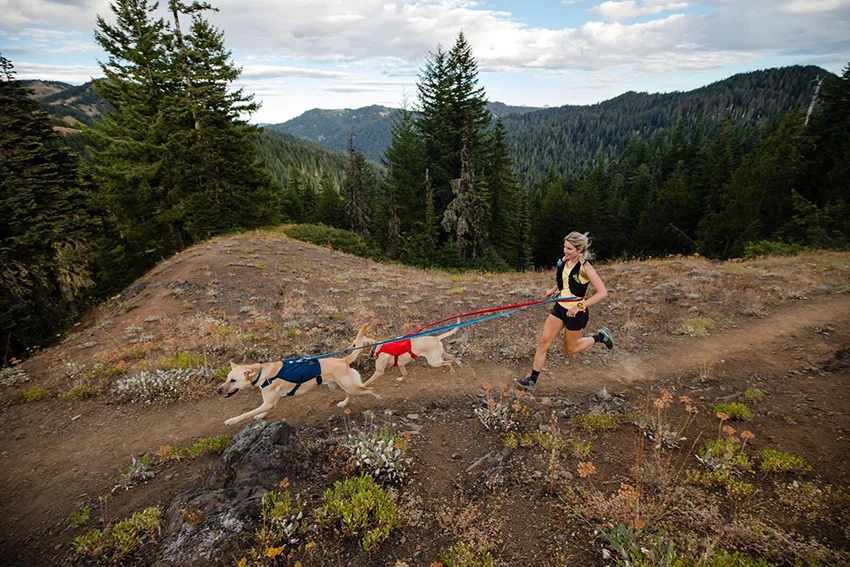
Here are a few more things to consider before you bike with a dog.
Start Slowly in the Beginning
Start slow when training your dog to go biking to build their confidence, physical stamina, and understanding of commands associated with the activity.
Gradually introducing biking in short, controlled sessions allows your dog to adjust to the experience without overwhelming them, ensuring a positive and enjoyable learning process for you and your furry companion.
You also need to be comfortable using a biking leash for dogs, so go slow and take time to get used to it.
Safety First!
Prioritize safety when training your dog to go biking is paramount to prevent accidents or injuries to both you and your pet.
You reduce the risk of crashes if your dog is trained and acclimated to biking in a controlled environment. As the dog’s experience increases and their behavior becomes more predictable, so too can the pace of the bike ride.
Choose the Right Routes
Another key consideration is to plan your route and choose dog-friendly trails. Avoid busy areas with lots of wildlife, other dogs, and people.
Trail difficulty should also be considered; avoid very steep routes or rough terrain, as you want to be able to focus entirely on controlling the dog, not navigating the technical or challenging terrain.
Take It Easy on Warm Days
Dogs can’t regulate their temperature by sweating like humans do, so they quickly overheat on hot days. Take it easy by reducing the duration and intensity of your rides.
Additionally, make more frequent stops for water. Keeping an eye on your dog’s comfort levels helps to prevent any risk of heatstroke or burnt paws on hot pavement.
Benefits of Biking With Your Dog
Biking with your dog has many benefits in terms of health, bonding, training, and time-saving. Some of the most notable benefits include:
- Physical exercise for both you and your dog
- Important mental stimulation for the dog
- Bonding time for dog and owner
- Reinforcement of obedience training and commands
- Save time by giving the dog more exercise in a shorter period than walking would
How to Know If Your Dog Is Ready for Biking?
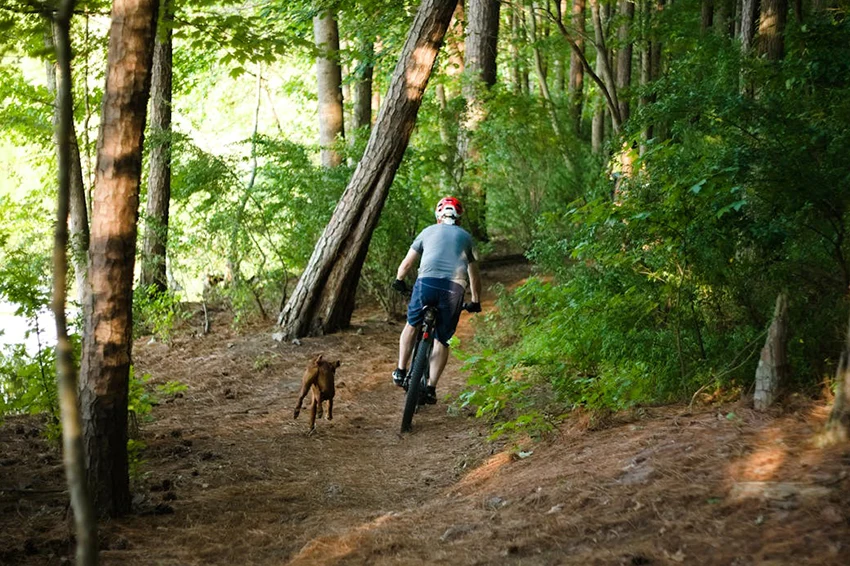
So, when can you confidently say that your dog is ready to bike with a dog leash?
Physical Fitness: Ensure your dog is in good physical condition and fit enough to handle the physical exertion of running alongside a bike. Consider your dog’s age, breed, size, and overall health. See how they respond to various paces and terrains when introducing them to the bike.
Obedience Training: They should reliably respond to commands on and off-leash, especially in distracting environments. Make sure your dog reliably obeys commands such as “sit,” “stay,” “come,” and “slow.”
Leash Manners: First, take your dog for walks using the harness to adjust them to its feel. Then, practice walking and running with your dog on the leash to see how they maintain a consistent pace and if they pull or lunge. Correct them as needed.
Socialization: Ensure your dog is well-socialized and comfortable encountering other people, dogs, and distractions while biking. Exposure to various environments and experiences will help your dog remain calm and focused during outings.
Desensitization to Biking Equipment: Introduce your dog to biking equipment gradually, including the bike itself, harness or leash attachments, and any safety gear such as helmets or reflective vests. Soon, your dog will become familiar with these items and will be easier to control on the trail.
Trail Etiquette: Familiarise yourself with trail etiquette and regulations regarding biking with dogs in your area. Choose appropriate routes for biking with a dog and adhere to leash laws and trail rules to ensure safety for you, your dog, and other trail users.
Behavioral Cues: Pay attention to your dog’s body language and behavior during those first gentle rides. See how enthusiastic and confident your dog feels around the bike, and try to encourage the elements that increase your dog’s enjoyment. Look for any signs of stress or discomfort that may indicate they are not ready for biking and tailor further training sessions to suit.
By carefully assessing these factors and gradually introducing biking in a controlled and positive manner, you can decide if your dog is ready. Adjust the length and speed of rides as your dog’s fitness may quickly increase. Be patient, consistent, and attentive to your dog’s needs throughout training.
Biking Dog Leashes on Amazon

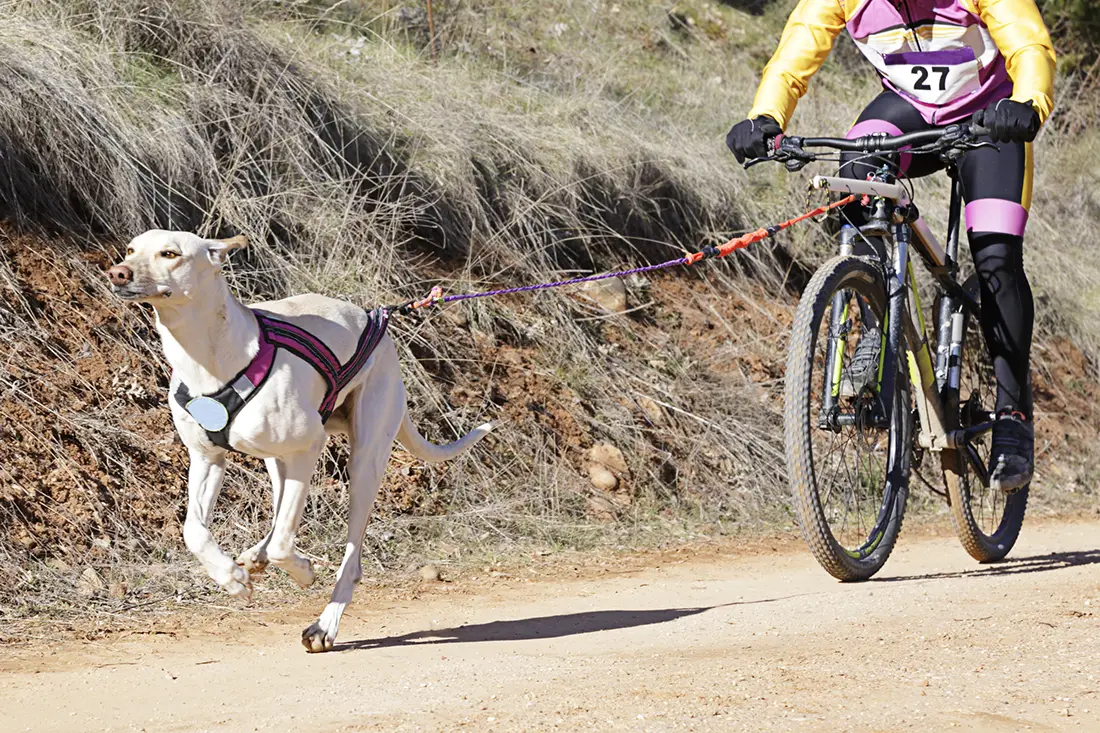



Your commitment to excellence is commendable.